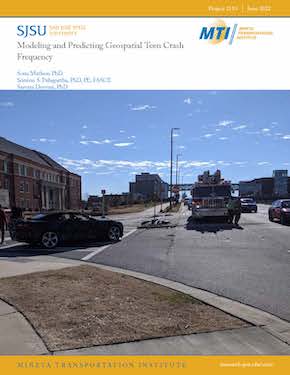- 408-924-7560
- mineta-institute@sjsu.edu
- Donate
Modeling and Predicting Geospatial Teen Crash Frequency
This research project - 1) evaluates the effect of road network, demographic, and land use characteristics on road crashes involving teen drivers, and, 2) develops and compares the predictability of local and global regression models in estimating teen crash frequency.The team considered data for 201 spatially distributed road segments in Mecklenburg County, North Carolina, USA for the evaluation and obtained data related to teen crashes from the Highway Safety Information System (HSIS) database. The team extracted demographic and land use characteristics using two different buffer widths (0.25 miles and 0.5 miles) at each selected road segment, with the number of crashes on each road segment used as the dependent variable. The generalized linear models with negative binomial distribution (GLM-based NB model) as well as the geographically weighted negative binomial regression (GWNBR) and geographically weighted negative binomial regression model with global dispersion (GWNBRg) were developed and compared. This research relied on data for 147 geographically distributed road segments for modeling and data for 49 segments for validation. The annual average daily traffic (AADT), light commercial land use, light industrial land use, number of household units, and number of pupils enrolled in public or private high schools are significant explanatory variables influencing the teen crash frequency. Both methods have good predictive capabilities and can be used to estimate the teen crash frequency. However, the GWNBR and GWNBRg better capture the spatial dependency and spatial heterogeneity among road teen crashes and the associated risk factors.
SARVANI DUVVURI, PHD
Dr. Sarvani Duvvuri received her Ph.D. in Infrastructure and Environmental Systems (INES) from the University of North Carolina at Charlotte, NC, where she is currently a Postdoctoral Researcher with the Infrastructure, Design, Environment, and Sustainability (IDEAS) Center. Her current research interests include traffic operations and safety, traffic simulation, and connected and automated vehicles.
SRINIVAS S. PULUGURTHA, PHD, PE, FASCE
Dr. Srinivas S. Pulugurtha, P.E., F.ASCE is currently working as a Professor and Research Director of the Department of Civil and Environmental Engineering at the University of North Carolina at Charlotte. He is also the Director of the IDEAS Center.
SONU MATHEW, PHD
Dr. Sonu Mathew received his Ph.D. in Infrastructure and Environmental Systems (INES) from the University of North Carolina at Charlotte, NC. He is a Postdoctoral Researcher with the IDEAS Center. His current research interests include traffic safety, traffic flow modeling and simulation, ITS, connected and automated vehicles, and spatial modeling.
-
Contact Us
San José State University One Washington Square, San Jose, CA 95192 Phone: 408-924-7560 Email: mineta-institute@sjsu.edu






